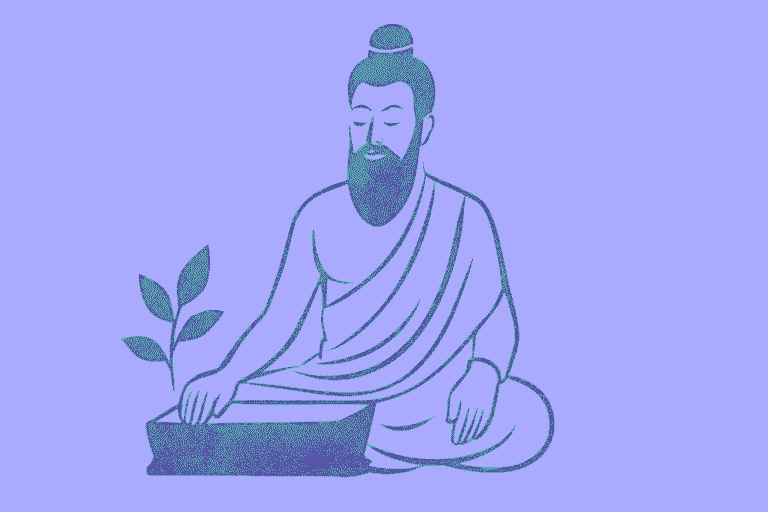contact@cayeit.com
The Ayurvedic Outlook on Positivity:
Ayurveda recognizes that our mental state and outlook exert powerful influences on our overall health and wellbeing. A positive mindset anchored in sattva (purity and balance) is viewed as foundational for holistic health. From dinacharya (daily routines) to ritucharya (seasonal routines) and rasayana (rejuvenation), Ayurveda prescribes numerous pathways for cultivating positivity, fulfillment and purpose. Practices like meditation, yoga, pranayama and chanting of mantras balance the doshas, enhance ojas (vitality), purify the mind and infuse our consciousness with sattva. Ayurvedic herbs like brahmi and ashwagandha improve mood and cognition, reducing anxiety and stress. Following Ayurvedic dinacharya aligns our natural circadian rhythms with nature’s cycles, promoting harmony and positivity. Ayurveda’s comprehensive toolkit aids in maintaining a positive temperament amidst life’s inevitable ups and downs.
Adopting an Attitude of Gratitude:
Cultivating gratitude is a pivotal Ayurvedic practice for enhancing positivity. Taking time to reflect and appreciate what we have helps counter the mind’s tendency to fixate on problems and negatives. The Charaka Samhita recommends expressing gratitude every day towards our teachers, parents, elders, nature and the Divine. Here are some tips:
- Begin your morning meditation session with prayers of gratitude. Express thanks for your health, loved ones and the day ahead.
- Maintain a gratitude journal where you log positive events, big and small, on a daily basis. Reflect on what you are grateful for.
- Perform karma yoga by volunteering for a cause you care about. Helping others fosters gratitude.
- Spend time mindfully savouring your meals, appreciating their nourishment for your body.
- Take a nightly inventory of the day’s blessings, lesions and accomplishments.
- Convey appreciation directly to people who have supported you.
Cultivating gratitude generates positive emotions, reduces stress, improves sleep and boosts overall wellbeing. It is an essential Ayurvedic practice.
Living in Sync with Nature:
Ayurveda recognizes our interconnectedness with all of nature and prescribes aligning with natural rhythms for balance and positivity. Here are some recommendations:
- Rise and sleep in tune with the sun for robust circadian rhythms. Wake-up gently before sunrise.
- Expose yourself to morning sunlight and get Vitamin D. Take evening walks for fresh air and to see sunset.
- Eat in sync with agni (digestive fire), with the heaviest meal at mid-day when agni is strongest. Eat lighter later.
- Follow food guidelines for each season like lighter foods in summer and warming soups in winter. This pacifies the doshas.
- Incorporate organic, sattvic foods into meals for purity of mind-body. Favour seasonal fruits/vegetables.
- Find recreation in nature – hiking, camping, gardening, farming. Relax through vedic gardening.
- Express creativity by using natural materials like clay, wood, glass for arts, crafts.
- Be aware of nature’s intelligence and consciousness in every living thing. Look for lessons in natural phenomenon.
- Perform rituals on auspicious nature days – full moon pujas, summer/winter solstice rituals, blessing seeds during Navratri.
- Live in harmony with the elements – fire, water, air, earth, space – using materials and colours aligned with their qualities.
Bringing awareness to nature’s perfection instils faith in the cosmic order. Following natural rhythms enhances positivity. As the Chandogya Upanishad states, the key is to be “in harmony with the infinite”.
Balancing the Three Gunas through Yoga:
The ancient Vedic text of Bhagavad Gita identifies three subtle qualities or gunas – sattva, rajas and tamas – that constitute all mind-matter. An excess or deficiency of any guna leads to disharmony. Yoga balances the three gunas for optimal health and positivity. Key practices include:
- Asanas like tree, mountain and staff pose develop sattva by stabilizing the body and concentration.
- Forward bends pacify rajas, while backbends temper high tamas. Twists rebalance all three.
- Pranayama like nadi shodhana (alternate nostril breathing) calms rajas and activates sattva through rhythmic breathing.
- Cooling pranyamas reduce agitated pitta and can purify tamas. Heat generating ones pacify kapha.
- Chanting mantras like Om raise sattva. Listen inwardly to their resonance.
- Meditation initially reduces tamas by developing awareness. Deeper meditation increases sattva.
- Bhakti yoga’s devotional practice nurtures sattva through pure love.
- Seva yoga’s selfless service reduces selfish rajas and tamas.
- Jnana yoga study fosters wisdom for gaining unified perspective beyond the gunas.
Thus yoga comprehensively develops sattva while regulating rajas and tamas. Regular practice leads to harmonious state of sat-chit-ananda (truth-consciousness-bliss).
Making Friends with Silence through Yoga Nidra:
Yoga nidra is a powerful practice from Tantra for accessing deeper states of consciousness characterized by inner silence. By relaxing deeply while maintaining awareness, yoga nidra allows the mind to temporarily transcend the noise of thoughts, emotions and samskaras (mental impressions). This opens doorways to higher aspects of the psyche beyond the limitations of everyday waking consciousness dominated by the three gunas. Practicing yoga nidra for 20-30 minutes daily has significant impact:
- It calms excessive rajas (activity) and tamas (dullness). The mind becomes sattvic and tranquil.
- By silencing the fluctuations of mind (vrittis), it enables realization of purusha, the true peaceful Self.
- It dissolves stress by accessing parasympathetic relaxation while conscious.
- It harmonizes left and right brain hemispheres, strengthening intuition.
- It boosts creativity by connecting with the subconscious realm.
- The inner silence enriches daily life by providing an anchoring in inner peace.
Regular yoga nidra practice makes the mind profoundly positive. Even a short 10 minute yoga nidra session during the day can relax the mind when feeling overwhelmed. Yoga nidra is a portable refuge always available within.
Applying Sattvic Concepts to Thoughts and Environment:
In Ayurveda, sattva represents purity, harmony and the highest level of consciousness permeating creation. Here are some tips to increase sattvic quality:
- Thoughts: Soak the mind in positive thoughts of truth, compassion, gratitude and wisdom from scriptures and poetry. Reflect on inspiring role models. Witness negative thoughts but don’t engage them. Practice loving-kindness meditation.
- Food: Favour light, nutritious, organic, vegetarian foods like fruits, nuts, legumes, vegetables, dairy, whole grains. Avoid stale, processed and tamasic foods.
- Spaces: Keep home and workspace clean, orderly and tranquil. Allow natural light and air. Decorate with plants, flowers and spiritual imagery. Keep calming essential oils. Play meditative music.
- Routines: Follow early bedtime and wake up routines. Spend time in nature and contemplative practices. Set aside electronic devices for ‘off-grid’ hours.
- Relationships: Associate with positive, wise and conscious people. Show empathy. Avoid toxic relationships that deplete energy. Be loving and compassionate.
By integrating sattvic principles in thoughts, environment, lifestyle routines and relationships, we cultivate positivity naturally in alignment with our true nature.
Harnessing Sattvic Herbs for Positivity:
Ayurveda identifies certain herbs that are sattvic and elevate consciousness. When taken with spiritual practice, they amplify meditation benefits. Examples include:
- Brahmi: Renowned mental rejuvenator, Brahmi strengthens focus, memory and concentration. As a Medhya Rasayana, it improves intellect and cognition. It balances vata and kapha in the mind due to its nourishing, cooling effect.
- Tulsi: Sharpens intellect and enhances the flow of prana. It provides a sattvic upliftment that boosts positivity. Through its prabhav (special potency), tulsi calms the mind and heightens awareness.
- Ashwagandha: An adaptogenic rejuvenative, Ashwagandha reduces anxiety, stress and fatigue while promoting inner calm. It nourishes majja dhatu (nervous system) and improves comprehension.
- Jatamansi: Jatamansi has a medhya effect, improving concentration, cognitive processing and memory. It pacifies vata and pitta doshas, providing a calming effect.
- Shankhapushpi: Meaning “conch flower”, shankhapushpi has neuroprotective benefits. It enhances the three higher aspects of mind—dhi (acquisition of knowledge), dhriti (retention) and smriti (recall).
- Safed Musli: As a vitalizer and rejuvenative, safed musli reduces mental fatigue and improves vigour. It induces tranquillity and positivity.
Using these and other sattvic herbs infuses the mind with qualities essential for inner growth during spiritual practice.
Optimizing Daily Routine for Positivity:
The Ayurvedic science of right living – dinacharya – prescribes an optimal daily routine for harmony of body, mind and soul. Here are some tips:
- Wake before sunrise and offer a prayer of gratitude.
- Drink warm water to hydrate and energize. Do oil pulling to purify.
- Eliminate toxins through bowel cleansing and evacuation.
- Bathe and use aromatic pastes – like chandan or kumkumadi – for upliftment.
- Chant uplifting mantras or affirmations while getting ready.
- Meditate for 20-30 minutes to develop inner calm and awareness.
- Perform yoga to balance energies and recharge. Include pranayama and mudras.
- Take breakfast after yoga when agni is kindled. Avoid distractions during meals.
- Align work tasks with higher purpose beyond ego. Stay focused in the present.
- Take a contemplative break mid-day – even 10 mins of yoga nidra relieves stress.
- Spend evenings creatively or in spiritual company. Reflect on your day.
- Take early light dinner and wind down before bedtime while sipping herbal tea.
Using dinacharya to align with natural cycles, honour the Divine within, and balance activities with rest optimizes positivity.
Heightening Evolution through a Spiritual Outlook:
At its essence, Ayurveda provides guidance on raising consciousness towards transcendence of the limited ego-self and realizing our infinite potential. Some keys for spiritual evolution:
- Develop a witnessing attitude. Observe thoughts and emotions with equanimity. Don’t get entangled in their grip.
- Perform all work with complete attention yet without obsession over outcomes. Fulfill duties diligently.
- See all creation as manifestations of the Divine. Treat everything with love, compassion and wisdom.
- Consider life’s challenges as opportunities for growth. Face adversities courageously.
- Cultivate timeless values like truth, righteousness, love, forgiveness, non-violence and seva (service).
- Spend time daily in meditation/ self-reflection to connect within. This gives direction amidst outer chaos.
- Progressively replace identification with ego/ labels with your true Self – the sole constant underlying all change.
- See life as a marvellous play. Play your role vibrantly with full involvement, yet with detached wisdom.
- Consider karmic relationships as divine opportunities for transmuting past impressions while also evolving.
By anchoring in higher purpose, we gain a positive spiritual outlook that enriches life with meaning and grace.





